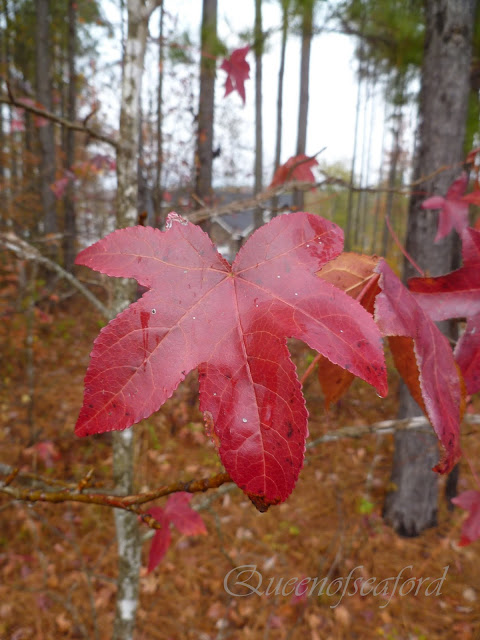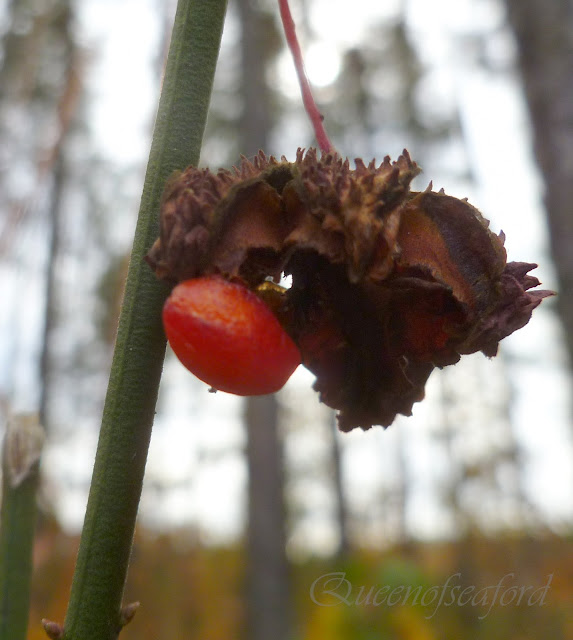The mighty American Chestnut tree, the once grand giant tree is on the verge of disappearing. Many of us know of the Chestnut Blight, Cryphonectria parasitica, and its affect on the tree. At the turn of the last century the American Chestnut started dying in large numbers. This fast growing, large tree, was developing cankers. These cankers run around the cambium layer of tree, killing first the leaves, then branches, and finally all above ground plant material is dead.
The American Chestnut, Castanea dentata, once had a native range from Maine to Georgia and west to Ohio. It was approximately 25% of the forest. It is now either on endangered species list or special concern lists for many states.
It is a fast growing, straight tree that can achieve heights over 100 feet in good conditions. A mature tree can have a diameter of 17 feet. These were huge trees. Interestingly it was branch free on the lower part of the tree, sometimes up to 50 feet of trunk before branching.

It was called the cradle to coffin tree. From fine furniture to railroad ties, fuel to posts, this tree constituted more than 50% of the timber produced before the blight. The timber is decay resistant, making it a useful wood for many applications. Wildlife benefited from its nut production. Bears to raccoon to deer to humans, everyone found the nut a good food source. Trees will fruit 5- 7 years of age. It needs another Chestnut to cross pollinate even though it is monoecious. Much of the economy was based on the American Chestnut. The bark and the wood were a great source of tannic acid, used for tanning leather. After the blight killed a tree, the timber that remained was still used. Worms had bored into the wood, so timber harvested after the blight was called wormy wood (holes).

Chestnut blight was first discovered in the USA in 1904 on some trees newly planted in the New York Zoological Garden. Many Japanese Chestnuts, Castanea crenata were imported as early as 1876 by mail order. Chestnut blight, Cryphonectria parasitica, (known as Endothia parasitica - name changed 1978) spread as far north as Ontario. One attempt to stop the spread of the blight was to create a firewall, sadly eliminating many healthy trees. This practice was stopped after World War One. By the 1940's there were more than 3 1/2 BILLION Chestnuts lost to blight. Chinese Chestnut, Castenea mollissima, is resistant to blight, more on that in a little bit.
Blight is a fungus and is spread by airborne spores. The spores are dispersed by animals, including man, and insects. It can colonize on other plants, including oaks. Chinquapin Oaks, Quercus muehlenbergii and Live Oaks, Quercus virginiana, are affected by blight.
Sadly, blight is not the only thing that is killing American Chestnuts. Meet Dr. Joe James, adjunct professor of Forestry, Clemson University. Our Master Gardener group had Dr. James come and speak to us about his research with American Chestnuts.

On his farm in Upstate South Carolina, he used to have a number of Chestnuts. As they died he started doing some detective work. Calling on the Forestry Department of Clemson, it was discovered that the roots were dying from Phytophthera root rot.
Phytophthera cinnamomi is a soil borne organism. It is another import from Asia. It is believed that it was imported by wealthy Charleston landowners in the late 1700's, bringing new plant material into the country. This is not a fungus but similar to red algae, it is a
oomycete (also called a water mold), has its own phylum. It spreads through the soil, slowly. Water can carry it to new locations. It needs moist soil to live, dry conditions kill the oomycete but not the spores. Frozen conditions kill it. Here in the South, even if we have a cold winter, our soil does not freeze to the bedrock. Mountain tops and further north this is not an issue.
P.cinnamomii can remain dormant in the soil.. It is called Black Ink disease as the infected roots look as if black ink is being taken up through its cellular system. Many plants are susceptible to it, 100% lethal to American Chestnuts. The root rot girdles at the root collar, killing the tree. Chinese Chestnut is immune to Phytophthera cinnamomii. That is the good news.

Dr. James is part of a research program with cross breeding the American Chestnut with the Chinese Chestnut. This breeding has been going on for a number of years, breeding into the American Chestnut, the resistance to Blight. Each generation of this hybrid is tested by inoculating these new trees with blight spores. Successful resistant trees are then crossed again with another American Chestnut, breeding out the Chinese characteristics except for its resistance to blight. This is producing trees that have a fraction of Chinese Chestnut genes, the new American Chestnut hybrid. Dr. James receives nuts produced from these trees, now blight resistant, and runs trials with various family groups (different lineage tree families), testing them for resistance of Phytophthera root rot. One strain of Phytophthera is introduced to the roots after the seedlings start growing. Many die, but the survivors are transplanted into berms from the tubs they started in. Once the tree has survived three years in the test mode, it is transplanted into the wild. It will take many years for Chestnuts to return to the grand size that they once were. This fascinating research bringing back this beautiful tree.

The pictures of the small, understory trees at the top of the post were taken this past May, at the North Carolina Arboretum. While on our guided tour, Tim Spira pointed out these small trees. The blight keeps killing off the top growth. Blight is coppicing (pruning to the ground to encourage suckering) these trees. The new sucker growth will again be attacked by the blight, never allowing these trees to grow to their size of years ago.
I did a posting on the
Chinese Chestnut. I have since learned more about the differences between American and Chinese Chestnuts. The leaves-- American-- longer than width, prominent teeth which curve like waves breaking, base of leaf tapers sharply, leaf is thin and papery. Chinese -- oval shaped, smaller teeth, base is rounded, leaf is waxy and thick. The nuts are different, American nut is smaller, sweet, has fine hairs on the bottom of the nut. Chinese nut is larger and less tasty.
There is also some genetic research being done with isolating the gene that has the resistance to blight and phytophthera. Many are working at bringing this tree back.
This has been an interesting post for me to write, truly a learning experience. My references online were
USDA Plant Profile,
Duke,
VA Tech,
NC State,
Appalachian Woods, and
Columbia University. My notes from Dr. James' talk were also used as well as a copy of "The Journal of the American Chestnut Foundation" issue on 'Phytophthora- The Stealthy Killer that Attackes Southern Chestnuts' September /October 2011. I did double check my notes with online information.
©Copyright 2012
Janet. All rights reserved. Content created by Janet for
The Queen of Seaford.
 words and photos by Janet,The Queen of Seaford.
words and photos by Janet,The Queen of Seaford.









































